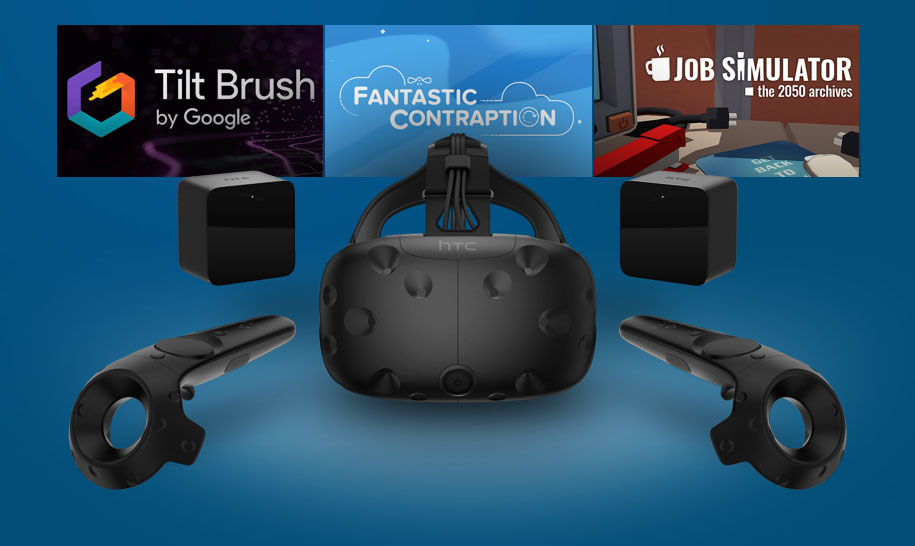It can be argued that virtual reality became something to be taken seriously when Facebook purchased Oculus VR in 2014 for $2 billion. However, the field didn’t really become a race until the HTC Vive was announced at the 2015 Mobile World Congress, eclipsing most other news and announcements that came from the event. Developed in partnership with Valve, creators of the Steam gaming platform, this premium headset would give the Oculus Rift some genuine competition, and soon after, you rarely heard one mentioned without the other.
This is how a virtual reality device from a phone manufacturer leapt into the spotlight a year ago go head-to-head against the Oculus Rift.
Steam Powered
Although the games on Steam don’t necessarily favor the HTC Vive (in fact, many of them are developed for the Oculus Rift), being associated with Valve goes a long way. Valve has long been a highly respected company that has developed incredibly successful games like the Half-life series, Counter-Strike: Global Offensive, and DOTA 2. Partnering with HTC to develop a headset alongside the SteamVR platform gave the Vive instant credibility, and it soon grabbed as much attention as the Oculus Rift, which had been covered by tech media for months, even before the Facebook purchase.
That credibility was later backed by hands-on demonstrations which took place a week after its announcement, at GDC 2015. Everyone who tried the device was blown away, and it seemed like the Vive might overtake the Oculus Rift in popularity. Especially since it announced the Lighthouse interactive motion tracking technology, which relies on sensors that can be installed into a wall, months before Oculus Touch was revealed.

Perhaps the most compelling news to come from the announcement was that the consumer version was expected to release in the fall of 2015, giving it an early lead over Oculus. Even though the device quietly missed that release window, and got delayed to April 2016, consumers were quick to forgive. The partnership continued to pay off, with Valve hosting a SteamVR Showcase in January, which included 12 games for attendees to play. This helped to strengthen the future of VR, since its success will be rely heavily on content. Furthermore, a link to pre-purchase the HTC Vive is prominently displayed on Steam, exposing it to millions of users.
Premium Hardware
With a $800 price tag ($200 more than the Oculus Rift), it’s clear that the HTC Vive is at the top of premium VR headsets. However, that hasn’t stopped the first 15,000 pre-order units from selling out within 10 minutes, according to an HTC employee.
Woah, more than 15k units in less than 10min 😮
— Shen Ye (@shen) February 29, 2016
However, early adopters will be getting quite a bit for their money. The HTC Vive boasts a better screen, and it almost stole the Oculus Rift’s thunder when it demonstrated how Lighthouse could track more than head movements. It could track a person’s whole body, which allowed users to stand up and walk around a 15×15 foot space. The sensors could also detect walls and objects, and helped prevent people from bumping into them.
HTC revealed in January that the headset would include a front-facing camera, which lets users see real world objects without having to leave the virtual one. While that might seem like a minor feature, it turned out to be a major innovation that allows users to walk freely and interact with others without being cut-off from the real world.
The company also announced partnerships with hardware manufacturers like HP, Alienware (Dell), and MSI to promote their brands of “Vive Optimized” systems to take some the guesswork out of finding the right computer to power the headset.
In addition to being bundled with wireless VR controllers, the HTC Vive will also include three games: Job Simulator, Fantastic Contraption and Tilt Brush by Google. Although the Oculus might initially offer a broader library of games, which includes EVE Valkyrie, many experiences may work on either device. Plus, the partnership with Valve will continue to make the Vive a premiere device for developers to consider.
So, despite the higher price tag, and the Oculus Rift became available for purchase first, the HTC Vive manages to keep a tight race going through strategic partnerships and incredible presentations.

